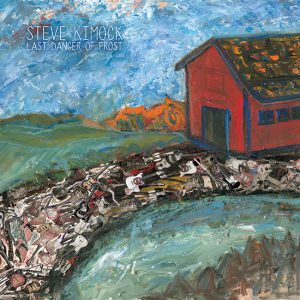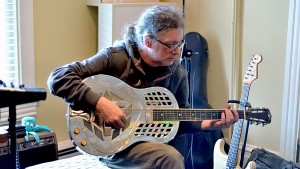Steve Kimock talks his new record, his first guitar, and how he became known as an heir apparent to Jerry Garcia.
Podcast: Play in new window | Download
Subscribe: RSS
Steve Kimock has played with just about every member of The Grateful Dead. With his own groups, he plays pays extended guitar centric compositions full of improvisation, and he’s often mentioned in the same breadth as bands like Phish and The String Cheese Incident. But don’t dare call his group a jam band.
“That was like a slur against, you know, small band improvisational music,” Kimock reveals. “And I was like oh man, I would like to find a guy that started that and just, you know, give him what for.”
“I never thought of it as a slur,” I counter.
“That’s how it, yeah, that’s how it started, man, I’m sorry,” he replies.
“I thought it was a badge of honor, actually,” I continue.
“Hardly,” he retorts.
David Gans is the host of the Grateful Dead Hour and author of several books on the band, including This is All a Dream We Dreamed: An Oral History of the Grateful Dead. He understands where Steve Kimock is coming from.
“I think a lot of people do because the jam band scene is noted for self-indulgent guitar playing, poor songwriting, no attention whatsoever to the vocals and other traits that aren’t desirable,” clarifies Gans.
“This is a very different thing,” Kimock elaborates, “A very personal thing for me and it’s not so much about the music as it is about having you know, the freedom to interpret whatever the energy is at that gathering of people, you know, and then doing as little is necessary to make it right.”
Steve Kimock has been around for a while. Now in his early 60s and he’s sitting in the Echoes studio after a live session. He’s got a steel-topped resonator guitar on his lap, his long grey hair pulled back in a ponytail. He isn’t a household name like Phish or the Dead but he has played with just about every Grateful Dead offshoot: Phil Lesh and Friends, Bob Weir’s Kingfish, Mickey Hart’s The Rhythm Devils, The Other Ones and more. For some people, that has put him in the line of succession to Jerry Garcia.
“He’s really popular in a certain segment of the Grateful Dead audience,” Gans reveals. “You know, it kind of got fragmented after Jerry passed and people kind of picked a new successor hero to Jerry. Some of them followed Phil Lesh and Friends, some of them followed Bob Weir and Rat Dog, and a lot of people kind of conglomerated around Steve, I think, as their new guitar hero as it were. And he sort of became an heir apparent to Jerry Garcia without ever really trying I don’t think.”
After growing up in the Bethlehem area of Pennsylvania, Steve Kimock made the pilgrimage west to San Francisco with his folk rock group, the Goodman Brothers in the mid-1970s. This was quite a shift for a guitarist raised in rural Pennsylvania.
“Talk about culture shock!” he recalls. “Man, suddenly there I was in in in San Francisco, you know, at the gig. And there were people there. Kurt Vonnegut Jr. was there. That screwed me up for life.”
Kimock quickly became part of that scene making connections with the Grateful Dead and forming a psychedelic band called Zero with guitarist John Cippolina of Quicksilver Messenger Service.
“It was an instrumental band, you know,” Kimock explains. “It was a band that we thought well, we’ll just have the guitars do the vocals.”
John Cippolina left the planet in 1989 and since then Kimock has played in many projects. Last year he released an atypical album called Last Danger of Frost. Instead of rock-based music, Steve went for a more atmospheric approach. It sounds like a rustic, ambient, world music orchestra of the imagination. It’s a sound Steve says goes back to his first guitar.
“I somehow managed to get like $12 Sears guitar that had a bridge that just sat on the top, like a trapeze tailpiece,” Kimock recounts. “It didn’t have the strings that went into the body, so the bridge sort of floated around, but I didn’t know how to tune it and I didn’t know how to play it, but I realized that if I pushed it, if I hit the strings and pushed the bridge around, it would make a noise. So I did that and I sat there on the bed all day, strumming the thing and making some horrible chord, and squishing the bridge back and forth across the top, making the pitch go. And I should’ve just stuck with just that just like it was you know. There’s like 30 years in between of trying to play it the normal way and I’m still like sliding up and down on some funny tune.”
Now that might make you think that Steve’s album is a noise experiment, but it isn’t. Another influence on Steve Kimock’s sound is avant-garde composer Harry Partch. In fact, one of his guitars is the same one that Partch would play.
“Harry Parch, maybe the, I mean for me anyway, to do sort of the granddaddy of all American micro-tonalists composers,” Kimock divulges, “he invented his own musical system, invented his own instruments, made incredible music. There’s a picture of him in front of one of this instruments called ‘Cloud Chamber’. But I was playing that exact same guitar that you know, like a 40s Regal square neck with the little decal down there, with a giant piece of pipe, you know, so yeah, there’s the slide-y thing. And I like that better than the fretted thing at this point.”
Steve Kimock’s Last Danger of Frost manages to be wildly experimental while also being inviting and melodic. But he says putting it together was no different from his usual process.
“This was more like a documentary, just sort of a snapshot of me running around in the studio looking for sounds,” Kimock concludes. “It’s found and improvised and just kind of built in the moment, you know. It’s what I would be doing normally.”
Except what he does normally, at least on record, usually doesn’t sound like this. Steve Kimock’s latest album is Last Danger of Frost on Big Red Barn Records.

